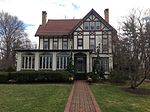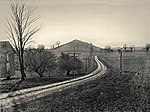Port Gibson United Methodist Church
19th-century Methodist church buildings in the United StatesChurches completed in 1871Churches in Ontario County, New YorkChurches on the National Register of Historic Places in New York (state)National Register of Historic Places in Ontario County, New York ... and 3 more
New York (state) church stubsOntario County, New York Registered Historic Place stubsRomanesque Revival church buildings in New York (state)
Port Gibson United Methodist Church is a historic United Methodist church located at Port Gibson in Ontario County, New York. The church was constructed in 1871 and is an imposing example of Romanesque Revival style. The front facade features a square, frame bell tower surmounted by a soaring, slate clad octagonal spire.It was listed on the National Register of Historic Places in 1996.
Excerpt from the Wikipedia article Port Gibson United Methodist Church (License: CC BY-SA 3.0, Authors).Port Gibson United Methodist Church
Greig Street,
Geographical coordinates (GPS) Address Nearby Places Show on map
Geographical coordinates (GPS)
| Latitude | Longitude |
|---|---|
| N 43.036944444444 ° | E -77.156388888889 ° |
Address
Greig Street 2959
14432
New York, United States
Open on Google Maps






